The Berkshires Bowling Alley that Inspired "The Big Lebowski"
It’s been 36 years since the release of The Big Lebowski, the irreverent cult comedy by Joel and Ethan


When on the East River or driving along the FDR Drive, you might notice a unique brick building with rounded iron balconies that feels distinctly of a different era, particularly in contrast to the NYCHA housing that surrounds it now. The building at 621 Water Street on the Lower East Side is the second location of Gouverneur Hospital, a hospital that is still in operation and known as Gouverneur Health. It was the first public hospital to open a tuberculosis clinic in the United States and was also the first to employ a female ambulance surgeon, a Dr. Emily Barringer.
Gouverneur Hospital opened its first location in Manhattan’s Financial District in 1885. The original three-story building on Gouverneur Slip and Front Street previously served as a public market and the hospital specialized solely in accident cases. Yet, the hospital lacked an operating room and had one visiting physician and surgeon, one consulting surgeon, and three house staff. With only 40 beds and inadequate resources to accommodate the growing population of the Lower East Side (with a concentration of 330,000 people per square mile), the hospital decided to move to the larger location on Water Street in 1901.
The land on which 621 Water Street sits on originally belonged to a loyalist during the American Revolution, but this land was then sold to a man named Lewis Ogden in 1788 after loyalists to Great Britain were mandated to give up their land. In 1897, construction of the new Gouverneur Hospital began on that land, costing $200,000.
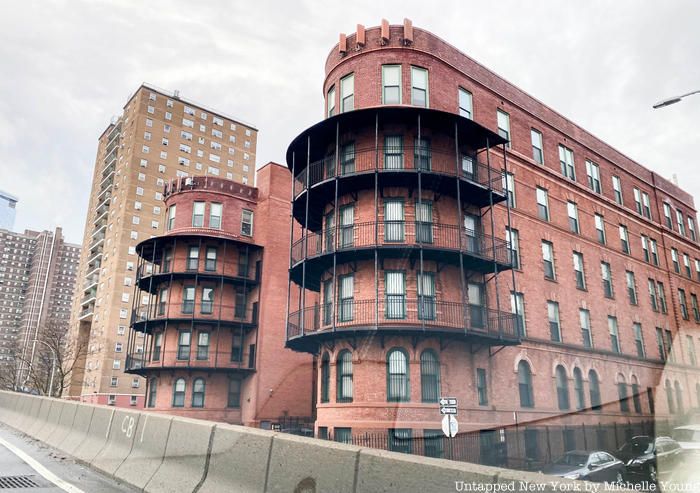
The red brick and terra cotta building by the architect John R. Thomas, was designed in the Renaissance style and opened in 1901 with four wards and 104 beds. You can see a historic image below in the Harvard University Art Museum collection of the hospital under construction in about 1900, with just one wing built. It shows the original five stories and a conical cap at the top — a sixth story was added later.
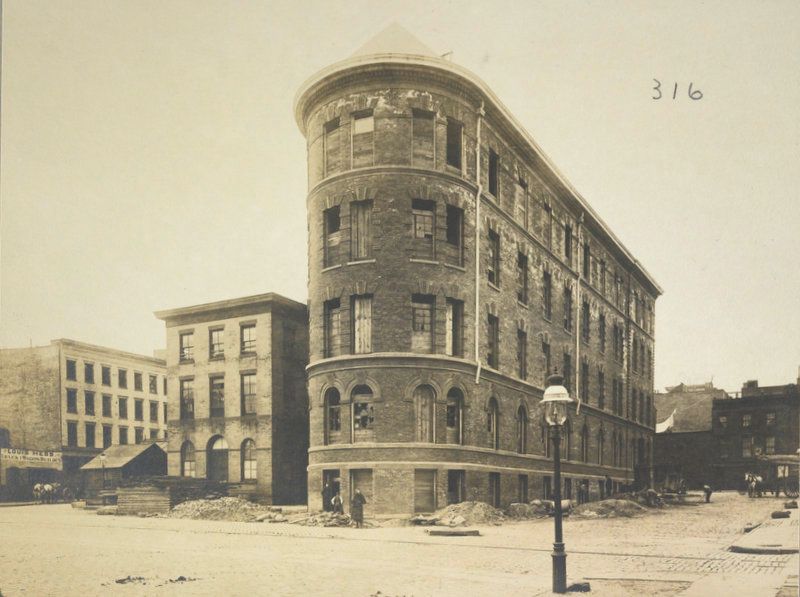
Gouverneur Hospital circa 1900 under construction. Harvard Art Museums/Fogg Museum, Transfer from the Carpenter Center for the Visual Arts, Social Museum Collection
Perhaps the hospital’s most iconic feature, its rounded iron balconies and the end two identical wings, were added in 1909. The New York Times notes that the building’s rounded shape “was an early attempt at preventive medicine” because “it was believed that tuberculosis bacilli hid in corners.” The use of rounded corners can also be seen in other hospitals of this time period, including the Ellis Island southside hospitals.
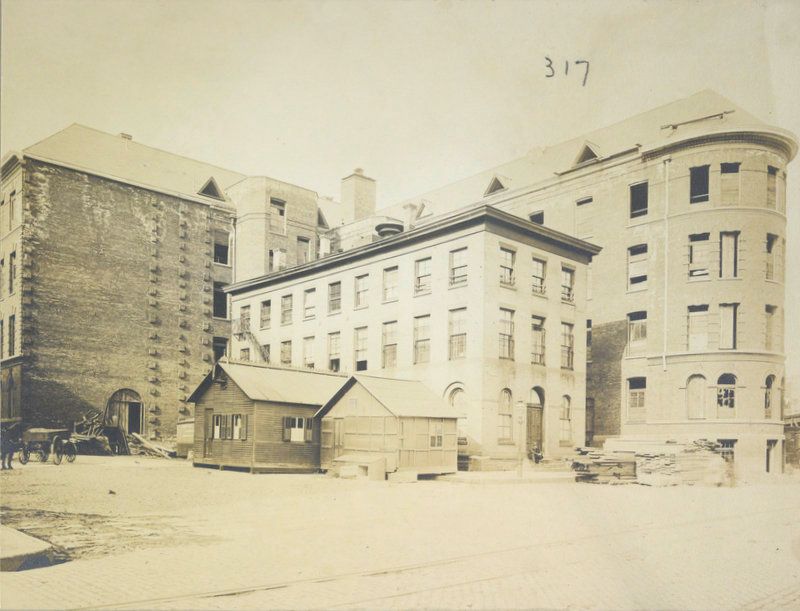
Gouverneur Hospital circa 1900 under construction. Harvard Art Museums/Fogg Museum, Transfer from the Carpenter Center for the Visual Arts, Social Museum Collection
Gouverneur Hospital also contained an x-ray machine and featured a staff of six doctors and eleven nurses. Early on in the hospital’s history, it treated victims of the cerebral meningitis and tuberculosis epidemics of the early 1900s. One of the hospital’s first cases involved John Bellinette, a man who was thrown from the fourth floor window of a nearby building after being accused of cheating a man out of money. Bellinette was admitted to the hospital in critical condition with a fractured skull.
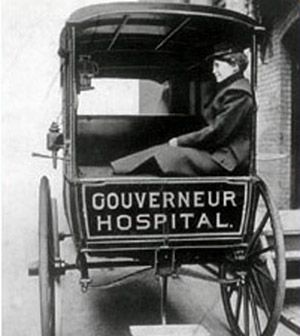
Emily Dunning Barringer in the back of a Gouverneur Hospital ambulance. Photo from Wikimedia Commons.
Right after the hospital opened, Dr. Barringer, who earned a medical degree in 1901 from Cornell University Weill Medical Center, decided to apply for a position at Gouverneur. After taking the qualifying exam for a position, she received the second highest grade, but was not offered the position since she was a woman. Yet one year later, after a new Board of Trustees took over, residency positions were offered to female candidates, and Barringer got the position, working in the back of a horse and buggy ambulance. Despite many objections by coworkers, she completed her residency in 1904, going on the serve as vice chair of the American Women’s Hospitals War Service Committee of the National Medical Women’s Association during World War I.
Throughout the next two decades, the hospital struggled to stay sanitary as it lacked a “detention room” for patients with infectious diseases. The children’s ward of the hospital had to be quarantined multiple times in 1913. Crime and gang activity in the hospital’s neighborhood also significantly increased in the 1920s, resulting in an increase in emergency cases for the Gouverneur ambulance team.
Similar to artistic efforts at the Neponsit Beach Hospital, the Works Progress Administration commissioned murals for Gouverneur in the children’s ward. Artist Abram Champanier, who designed murals for New York’s Roxy Theater, created a series of sixteen panels titled “Alice in Wonderland in New York.” In the social-realist style, Champanier depicted Alice in places like the East River, Coney Island, and the Central Park Zoo. A number of the murals have since been restored and distributed to hospitals including the new Gouverneur.
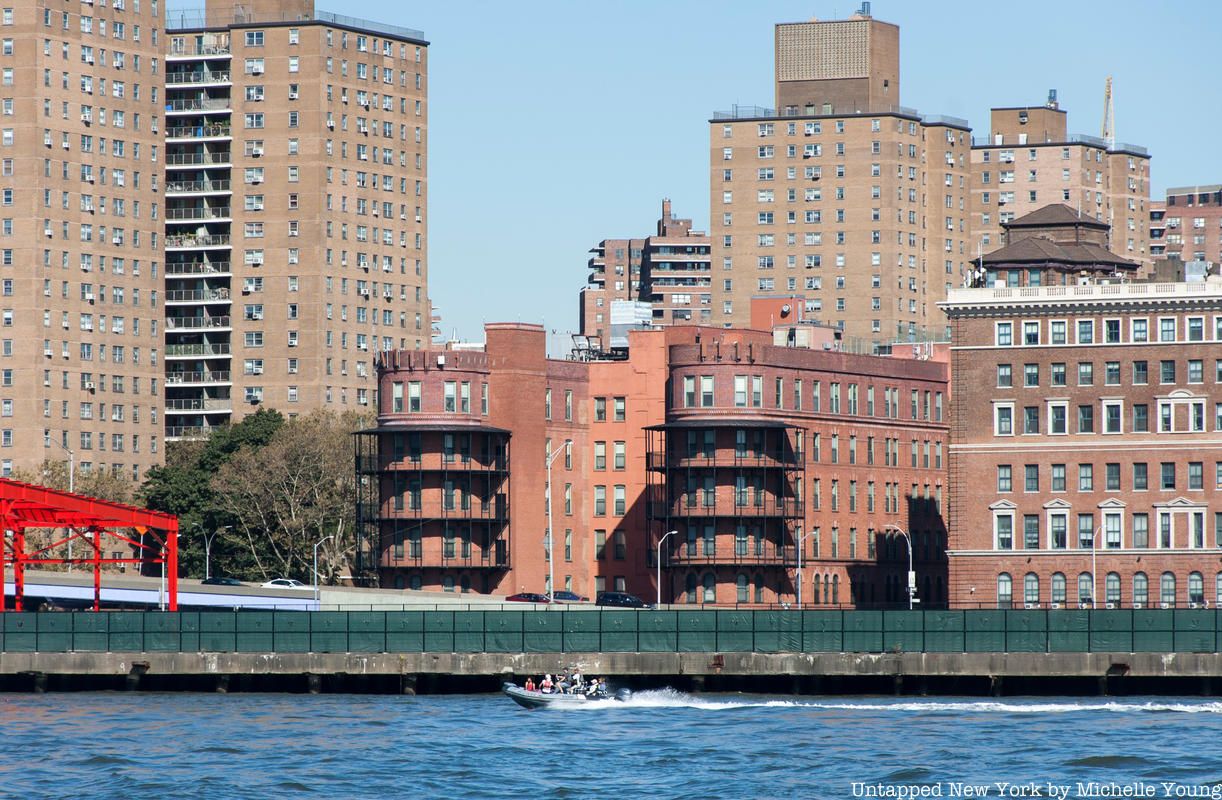
One of the nation’s largest healthcare plans, HIP, has its roots at Gouverneur as well. Doctor George A. Baehr created a prepaid medical plan charging 25 cents a month to assist tenants of the Vladeck Houses, which housed primarily low-income patients just nearby.
Despite Gouverneur’s work towards gender equity in the medical field and healthcare for all Manhattan residents, the hospital lost its accreditation in 1959, which led to talks of a shutdown. With only 151 beds to serve the growing population, the hospital was ill-equipped and struggled to stay afloat for the next decade. Throughout the 1960s, community members tried to save the hospital, some marching to City Hall in 1960 demanding it stays open until a more modern facility is built. The Puerto Rican activist group the Young Lords and the Health Revolutionary Unity Movement attempted to help hospitals including Gouverneur to create new hospital facilities and foster greater community involvement.
Although the hospital’s location at 621 Water Street closed in 1970, a new facility was constructed at 226 Madison Street Madison Street in 1972. The old Governeur Hospital was used as a school for children with special needs in the 1960s The old hospital was added to the National Registry of Historic Places in 1982, and the building was renovated into 123 apartments for homeless and special needs adults.
Today, the building is known as Gouverneur’s Court. If you happen to walk nearby, pay close attention to the impressive terra cotta detailing that still remains around the entrance and windows. Even the cell phone towers at the top of both wings are painted in brick red, camouflaged with the building!
Next, check out 12 groundbreaking hospitals that have closed in NYC.
Subscribe to our newsletter